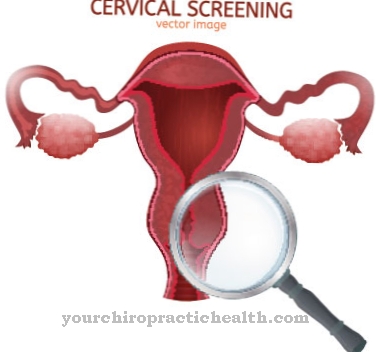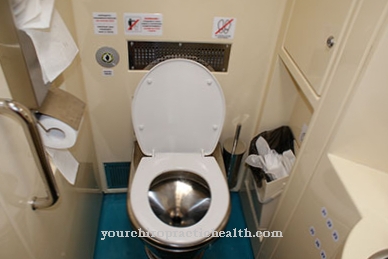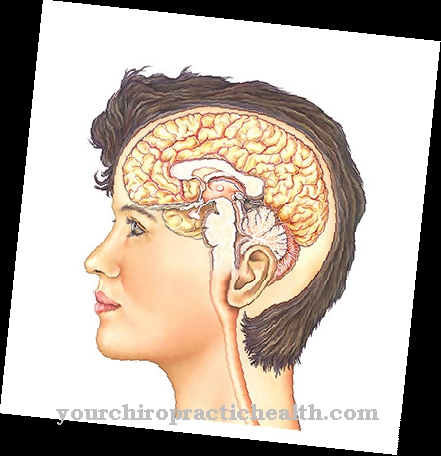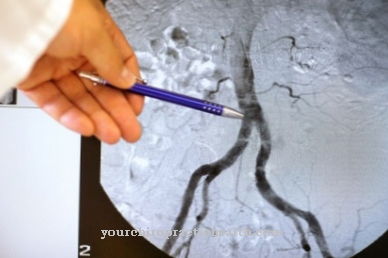The Aicardi-Goutières syndrome is an extremely rare, autosomal recessive inherited gene mutation that triggers a genetically heterogeneous developmental disorder in the brain of around three-month-old infants and, in addition to severe motor impairments, is associated with spasticity and epilepsy. For severe phenotypes, a maximum life expectancy of ten years is a guideline, although milder phenotypes with RNASEH2B mutations can possibly live to be more than ten years.
What is Aicardi-Goutières Syndrome?

The physician understands Aicardi-Goutières syndrome to be an autosomal recessive hereditary disease that corresponds to a genetically heterogeneous developmental disorder of the brain in babies around three months of age. Clinically, the syndrome has a similar appearance to an intrauterine infection, i.e. an infection that was acquired in the womb, but no pathogens can be detected as there is a genetic cause.
Certain cell nucleus enzymes are less active than usual due to the genetic defect and so clean the chromosomes significantly less of false RNA proteins. This leads to an accumulation of DNA segments in the cells. As this causes the cells to die, the immune system becomes active and causes inflammation in the relevant areas.
In 1984 the French doctors Françoise Goutières and Jean François Aicardi first described this phenomenon. Since then, fewer than 150 cases have become known, so the genetic defect is correspondingly rare. The individual cases have so far mostly been observed in families, since a second child will also develop the syndrome with a 25 percent probability.
causes
There is no acquired form of Aicardi-Goutières syndrome. The developmental disorder of the brain is always congenital and can be traced back to an autosomal recessive gene mutation. To trigger a disease outbreak, the defective gene must be present on both sides of the inheritance. However, new mutations are also possible. So far, five gene locations have been linked to the mutation.
These include TREX1, RNASEH2A, RNASEH2B and RNASEH2C as well as SAMHD1. The first descriptions of the syndrome assume a cause in connection with the gene TREX1 on chromosome 3p21. The RNASEH2-A genes are gene loci for three different proteins that play a role in the formation of the trimeric cell nucleus enzyme RNase H.
This cell nucleus enzyme is in turn responsible for removing incorrectly placed RNA molecule building blocks from the DNA. Without the RNase H, early embryonic death occurs. If, on the other hand, the cell nucleus enzyme is present but not fully active, individual fragments of certain genes are stored in the body cells. They cause apoptosis, which triggers an inflammatory process based on the natural immune reaction.
You can find your medication here
➔ Medicines for muscle crampsSymptoms, ailments & signs
Children with Aicardi-Goutières syndrome are difficult to feed. You have jerky eye movements and fidgeting and suffer from slight attacks of fever and vomiting. A little less than half of the affected children lose the motor skills they have learned up to now after around six months. With regard to motor skills, pyramid signs appear in particular.
In addition to spastic paralysis, there can be uncoordinated movements that cause the muscles of the arms and legs to contract or cause seizures. In addition to the disruption of muscle tone, organs such as the liver and spleen are sometimes enlarged. Later on there is an increasing delay in psychomotor development. Occasionally, frostbite-like skin changes also occur.
Diagnosis & course
In the differential diagnosis, the doctor must primarily rule out Toxoplasma parasites if Aicardi-Goutières syndrome is suspected. Computed tomography shows calcifications in the basal ganglia on both sides of AGS. Loss of brain matter and malformations of the brain matter can also be indications of computed tomography.
The nerve water examination shows an increased CSF lymphocytosis level and alpha interferons, which indicate an inflammatory process in the central nervous system. In the serum of AGS patients, the blood platelets are reduced and at the same time the liver enzyme values are increased. As far as the course of the disease is concerned, many of those affected still die in childhood, with ten years being the maximum life expectancy for particularly severe forms of the mutation.
Patients with milder forms often live to be over ten years old. These milder phenotypes mostly correspond to RNASEH2B mutations, which are present in almost half of all cases. The disease progresses at the beginning over several months until there is multiple disability. After these first months, however, the disease usually stabilizes on a steady course. Although so far almost all patients older than ten had to struggle with severe multiple disabilities, in individual cases significantly milder courses have occurred.
Complications
Aicardi-Goutières syndrome has severe complications that can have a very negative impact on people and children. In most cases, the syndrome shows up with difficulty feeding and eye movements that are jerky and uncontrolled. As the disease progresses, fever and vomiting become more common.
With Aicardi-Goutières syndrome, the children show spastic paralysis of the arms and legs, so that they can no longer coordinate and move them properly. In the worst case, seizures can occur, which can be particularly dangerous for children. Aicardi-Goutières syndrome also leads to mental retardation.
In most cases, the symptoms lead to death in childhood, so that life expectancy drops enormously. If the child does not die with Aicardi-Goutières syndrome, there will be considerable complications and difficulties in everyday life. Due to the physical and psychological limitations, the patient is always dependent on the help of other people and carers.
A stay in hospital is usually necessary. Aicardi-Goutières syndrome can also affect the liver and spleen, causing them to enlarge. This usually results in pain in the respective organs.
When should you go to the doctor?
In most cases, Aicardi-Goutières syndrome cannot be treated by a doctor. The patient dies after the first ten years of life. As a rule, the symptoms are already determined by a pediatrician. However, parents can contact a pediatrician if there are noticeable delays in development or in the development of various types of spasticity.
A visit to the doctor is necessary even with jerky movements and a strong and persistent fever. Usually medication can limit the fever and vomiting. It is not uncommon for the children to suffer from paralysis and cramps. These can also be restricted by treatment, so that in these cases a visit to the doctor is also recommended.
An emergency doctor can also be called in acute emergencies or seizures. It is not uncommon for parents to suffer from psychological complaints or from depression. In this case, the psychological treatment of the parents is recommended. This should be given psychological support, especially after the child dies from Aicardi-Goutières syndrome.
Doctors & therapists in your area
Treatment & Therapy
Aicardi-Goutières syndrome cannot yet be treated causally, but only treated symptomatically. In this context, seizures can be prevented by administering anti-epileptic drugs, for example. Physiotherapeutic measures are usually used to reduce spasticity and contractures.
Certain ointments and creams can be used against skin symptoms. The therapy options also include early intervention, during which not only the affected children but, above all, the parents are cared for.
Outlook & forecast
The Aicardi-Goutières syndrome leads to various malformations and stresses for the patient. The parents of the child in particular are often affected by severe psychological complaints and depression and therefore need psychological support.
The child himself suffers from severe disabilities and epileptic seizures. This leads to intense fever and vomiting. Often the child also suffers from uncontrollable movements of the eyes and paralysis in different parts of the body. Furthermore, seizures can occur, which are often associated with pain. The development of the child is severely restricted by the Aicardi-Goutières syndrome and motor disorders occur. The syndrome also negatively affects the central nervous system. The patient's quality of life is extremely limited and the person concerned is usually dependent on the help of other people in everyday life.
Aicardi-Goutières syndrome cannot be treated, so only the symptoms can be limited. The epileptic seizures can be reduced relatively well with the help of medication. Various therapies are also available to the patient.
You can find your medication here
➔ Medicines for muscle crampsprevention
A fetus can be tested for Aicardi-Goutières syndrome while still in the womb by taking an amniotic fluid sample. Expecting parents may then decide against the child. No other preventive measures are available because the syndrome is a mutation.
Aftercare
Follow-up care options are relatively limited in Aicardi-Goutières syndrome. The patient is always dependent on medical treatment to alleviate the symptoms and avoid possible complications. As a rule, the life expectancy of the person affected is also considerably reduced by the syndrome.
Since the condition is hereditary, it cannot be treated completely. A purely symptomatic treatment is available to the patient. If you want to have children, genetic counseling can also be carried out to prevent the recurrence of Aicardi-Goutières syndrome. Those affected are mostly dependent on taking medication.
These must be taken regularly, and the possible interactions with other drugs should also be considered. The children receive appropriate therapy and support in order to counteract the spasticity. However, they cannot be completely cured.
Contact with other sufferers of Aicardi-Goutières syndrome often has a positive effect on the further course of the disease. It is not uncommon for information to be exchanged and everyday life to be made easier. Furthermore, the parents are often also dependent on psychological treatment. Conversations with friends or acquaintances can also be helpful.
You can do that yourself
Aicardi-Goutières syndrome is a disease with multiple disabilities. Parents will have to seek permanent medical treatment with their child. The burden on the parents is very high and psychological support is highly recommended. Further professional help for the day-to-day care of the child should also be sought without hesitation.
If there are other children in the family, the possibility of placing them in a care facility should also be discussed. Since the sick child needs intensive care, the burden should not be underestimated. For parents with a sick child, the risk of depression is particularly higher. Taking care of one's own health - physically and mentally - should not be neglected. Parents can only be a stable support for their child if they are stable themselves.
Seizures and frequent vomiting require constant observation of the child. The child needs parental or professional care for all activities in daily life.
Parents must ensure sufficient movement through motor exercises, make the child's diet rich in vital substances and easily digestible, and ensure adequate fluid intake. Physiotherapeutic support is particularly important to reduce spastic attacks and accompanies drug therapy with anti-epileptic drugs. Parents can treat dermatoses supportively by carefully applying creams and ointments.





.jpg)







.jpg)

.jpg)
.jpg)











.jpg)